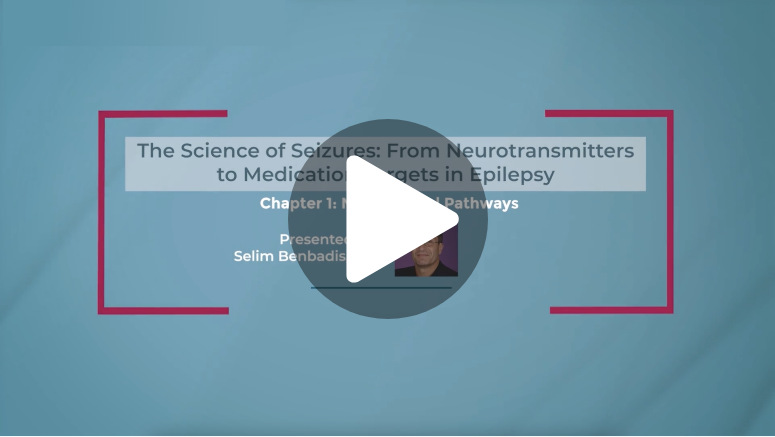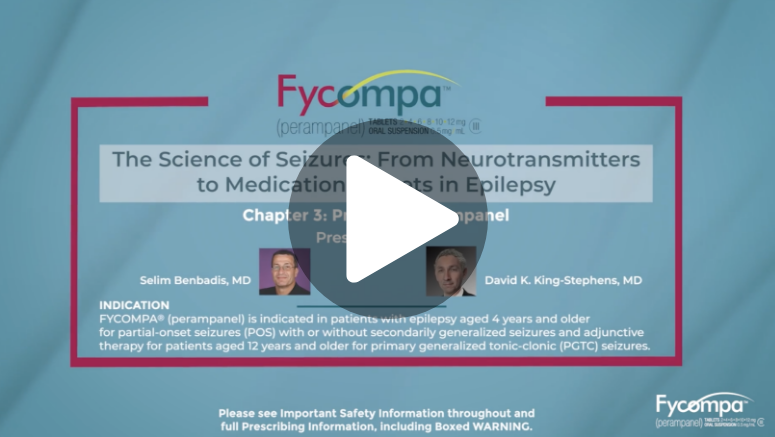[Music]
Hi, I’m Dr. David King-Stephens.
In this chapter, we’ll explore seizure etiologies and their proposed biophysical mechanisms, as well as the targets of currently available antiseizure medications.
Seizure etiology can be classified into 5 groups, along with a sixth “unknown” category.
Structural etiology refers to an abnormality visible on structural neuroimaging where the electroclinical assessment and imaging findings lead to a reasonable inference that an imaging abnormality is likely the cause of the patient’s seizures. This etiological group includes the relatively frequent finding of hippocampal sclerosis associated with mesial temporal lobe seizures.
Genetic etiology refers to seizures that result from known or presumed genetic mutations. For example, Dravet syndrome starts in infancy and continues through adulthood. It is characterized by a mutation in the sodium-voltage channel alpha subunit 1 in 80% of cases.
Infectious etiology refers to epilepsy that occurs directly from a known infection. Examples include neurocysticercosis, tuberculosis, HIV, and herpes simplex encephalitis.
Metabolic etiology refers to epilepsy that results directly from a known or presumed metabolic disorder, such as phenylketonuria, Glut1 deficiency syndrome, and uremia.
Finally, immune etiology refers to epilepsy that results directly from an immune disorder, usually with evidence of autoimmune-mediated CNS inflammation. This etiological group includes patients with systemic lupus erythematosus or Hashimoto’s encephalopathy.
According to a study that measured the proportion of incidence cases by etiology of epilepsy, the majority of epilepsy cases are idiopathic, while about 27% are structural.
Among epilepsy cases with presumed etiology, the most common underlying causes have been reported as perinatal incident, neoplasia, and trauma-related.
Neoplasia was the most common cause of newly diagnosed epilepsy assigned to a specific etiological category, regardless of age group.
Epilepsies caused by perinatal incidents are most common in children. Trauma and perinatal incident-related epilepsies are most common in the middle age group.
Epilepsy associated with stroke, trauma, and degenerative diseases are predominant in the oldest age groups.
Next, we’ll review the postulated mechanisms that may underlie these common etiologies.
In elderly patients, cerebrovascular insults such as stroke and ischemia precede the diagnosis of epilepsy for the majority of newly diagnosed cases with presumed etiology.
A postulated mechanism linking stroke to poststroke epilepsy centers on dysregulated glutamate signaling.
In the healthy brain, glutamate is removed from the synapse by EAAT1 and EAAT2.
Under ischemic conditions, brain oxygen and glucose are reduced, causing cellular energy in the form of ATP production to slow.
Reduced ATP causes dysfunction of the sodium-potassium ATPase, which maintains the sodium and potassium gradients across cell membranes.
Glutamate transport by EAAT1 and EAAT2, which is normally fueled by this gradient, functions in reverse, extruding glutamate back into the synapse.
As a result, elevated extracellular glutamate can lead to neuronal injury and epileptiform discharges.
In addition to this mechanism, rodent studies have shown that tonic GABAergic inhibition may be decreased after stroke, but synaptically localized GABAA receptor subunits were unchanged.
We mentioned that having a tumor is another common etiology associated with seizures and epilepsy. In fact, more than half of patients with gliomas experience seizures.
An invading glioma cell extrudes glutamate and takes up cysteine via the cysteine-glutamate transporter system, or xCT, resulting in increased extracellular glutamate.
Extracellular glutamate concentrations are further increased by diminished reuptake by EAAT1 and EAAT2.
This excessive glutamate in the synaptic cleft can activate glutamate receptors, promoting epileptic discharge.
In addition, rodent models have suggested that excessive glutamate in the context of glioma may cause downregulation of chloride potassium symporter 5, or KCC2, leading to impaired GABAergic inhibition.
About 5% of incident cases and about 20% of prevalence cases of epilepsy may be due to previous traumatic brain injury.
Preclinical studies in rodent models have shown that, similar to stroke and glioma, brain trauma disrupts the regulation of extracellular glutamate via both neurons and glia.
Recall that in the healthy brain, calcium entering the cell through voltage-gated calcium channels triggers glutamate release into the synapse. The transporters EAAT1 and EAAT2, primarily found on astrocytes, takes up the excess glutamate, keeping levels in check.
In brain-injured animals, calcium-dependent glutamate release via N-type calcium channels was no longer a source of extracellular glutamate.
In parallel, the uptake of glutamate by EAAT1 and EAAT2 was reduced.
Taken together, extracellular glutamate was increased, and there was a shift from presynaptic glutamate release to glutamate spillover.
Additional research in rodent models has suggested a possible role for GABA signaling in this model. Specifically, GABAA receptor subunit expression may be altered after traumatic brain injury, which may contribute to increased excitability.
Antiseizure medications, or ASMs, act on several targets that intersect with the neurobiology of seizures and epilepsy. Let’s review those targets.
Shown here are a number of ChASMs grouped by their primary proposed modes of action, although many of these medications may have known or hypothesized secondary targets as well.2
Several medications modulate voltage-gated ion channels, including sodium and calcium channels, which may help reduce neuronal excitability.
Other medications modulate GABA signaling, which may enhance inhibitory neurotransmission.
Another class of ASMs acts on the SV2A protein, which may help modulate presynaptic machinery.
One medication, perampanel, that antagonizes the AMPA receptor, may work to reduce glutamate activity at the postsynaptic site and prevent the synchronized firing that drives seizure propagation.
The mechanisms of other therapeutic agents remain elusive because they work on multiple targets, or the targets are not fully known.
Now please stay tuned for Important Safety Information for FYCOMPA (perampanel).
Perampanel is indicated in patients with epilepsy aged 4 years and older for partial-onset seizures with or without secondarily generalized seizures and as adjunctive therapy for patients aged 12 years and older for primary generalized tonic-clonic seizures
- FYCOMPA has a Boxed WARNING for serious psychiatric and behavioral reactions
- Serious or life-threatening psychiatric and behavioral adverse reactions including aggression, hostility, irritability, anger, and homicidal ideation and threats have been reported in patients taking perampanel, irrespective of prior psychiatric history, prior aggressive behavior, or concomitant use of medications associated with hostility and aggression
- Monitor patients for these reactions as well as for changes in mood, behavior, or personality that are not typical for the patient, particularly during the titration period and at higher doses
- Perampanel should be reduced if these symptoms occur and should be discontinued immediately if symptoms are severe or are worsening
In the partial-onset seizures clinical trials, hostility- and aggression-related adverse reactions occurred in 12% and 20% of patients randomized to receive perampanel at doses of 8 mg and 12 mg per day, respectively, compared to 6% of patients in the placebo group.
These effects were dose-related and generally appeared within the first 6 weeks of treatment, although new events continued to be observed through more than 37 weeks. These effects led to dose reduction, interruption, and discontinuation.
The combination of alcohol and perampanel significantly worsened mood and increased anger. Patients should avoid the use of alcohol.
Patients, their caregivers, and families should be informed that perampanel may increase the risk of psychiatric events.
Patients should be monitored during treatment with perampanel, especially when taking higher doses.
Antiepileptic drugs, including perampanel, increase the risk of suicidal thoughts or behavior in patients.
Patients, their caregivers, and families should be informed of the risk and advised to monitor and immediately report the emergence or worsening of depression, suicidal thoughts or behavior, thoughts about self-harm and/or any unusual changes in mood or behavior.
Perampanel caused dose-related increases in events related to dizziness and disturbance in gait or coordination, especially during the titration phase.
Perampanel caused dose-dependent increases in somnolence and fatigue-related events, especially during the titration phase.
Patients should be advised against engaging in hazardous activities requiring mental alertness, such as operating motor vehicles or dangerous machinery, until the effect of perampanel is known.
Patients should be carefully observed for signs of CNS depression when perampanel is used with other drugs with sedative properties because of potential additive effects.
Falls were more common in patients taking perampanel at doses of 8 mg and 12 mg versus placebo.
Drug reaction with eosinophilia and systemic symptoms, also known as multiorgan hypersensitivity, has been reported in patients taking AEDs, including perampanel. DRESS may be fatal or life-threatening.
Evaluate your patients if these signs or symptoms are present.
A gradual withdrawal is generally recommended with AEDs to minimize the potential of increased seizure frequency.
Caution should be exercised when perampanel is administered to pregnant or nursing women.
Use in patients with severe hepatic or severe renal impairment is not recommended.
Dosage adjustments are recommended in patients with mild or moderate hepatic impairment.
Use with caution in patients with moderate renal impairment.
Perampanel is a Schedule III controlled substance and has the potential to be abused and lead to drug dependence and withdrawal symptoms.
Thanks for watching this chapter. If you have not already watched Chapter 1 on this website, click on that to learn about the neurological pathways that are disrupted in epilepsy.
To learn about an antiseizure medication option with a unique mechanism of action, please watch Chapter 3 on this website.
And for more information about perampanel (FYCOMPA), please visit FYCOMPAonDEMAND.com



